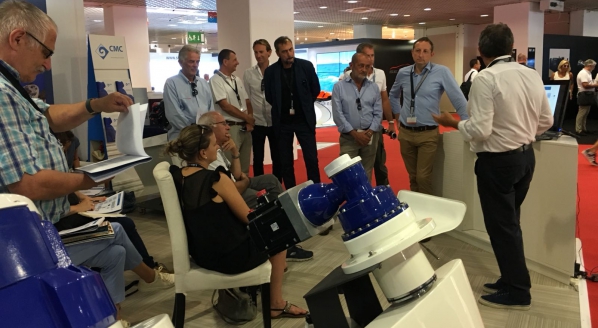Green technology for superyachts
Martin Richter from DNV GL – Maritime, looks at the green options for superyacht owners…

Martin Richter is principal engineer and ship type expert yachts at DNV GL – Maritime
The idea of making yachts, or ships, greener has been growing over the last several years in the maritime industry and recently, seems to be everywhere you look. In discussions with many shipyards and designers they tell us that their customers are both aware of environmental concerns, but even more than that as sailing and yachting enthusiasts they want to preserve the marine environment they hold so dear and enjoy it for years to come.
At DNV GL it’s a topic we have been focusing on for many years, especially as regulations have tightened, but it’s one where unfortunately we still see persistent confusion and misconceptions. Perhaps the greatest misconception or source of confusion is one that dogs the green debate generally: The idea that by choosing more sustainable options one is sacrificing performance while incurring greater costs.
Starting from the hull and coating, owners can work with yards and designers to ensure that they have a shape and coating that is optimized for how they want to use their vessel as well as the operational profile and location where they will be using the vessel. This can have a major impact on energy use and sustainability.
A prime consideration today is the propulsion options, from diesel and diesel-electric systems, to battery banks, to back up the onboard electricity grid, liquefied natural gas, and potentially fuel cells. Electrification, I believe, has a real potential to transform the yacht industry, so it is worthwhile going into some detail.
There are currently more than 250 all-electric or hybrid vessels either in operation or under construction, but what is really impressive about that number is that it has grown from practically zero over the last five years. We have had discussions with many yacht owners who are either contemplating retrofitting their existing craft or building new ones with a battery assisted power or hybrid propulsion system.
There are currently more than 250 all-electric or hybrid vessels either in operation or under construction, but what is really impressive about that number is that it has grown from practically zero over the last five years.
Including a battery system can have a host of benefits, reducing emissions, noise and vibration, maintenance and fuel costs, and ensuring compliance with current and future environmental requirements. However, integrating a battery bank into an existing or new vessel is a complex task that requires careful planning.
On yachts, batteries currently make the most sense in a hybrid scenario where they complement another power source to enhance flexibility. They can help run the machinery, including generator sets at optimum load, reducing fuel consumption and emissions to air; they can stabilize the onboard grid, avoid power blackouts, and enable silent operation for limited periods of time, for example in port or in marine sanctuaries. In combination with propulsion systems powered by LNG or other eco-friendly fuels, batteries can enhance the performance of these emission abatement technologies.
Adding batteries can, however, add weight, so the hull design will need to account for the weight distribution of the battery pack. To help customers who are looking at batteries, we can model and simulate on-board energy systems to determine the best way to use batteries on a given vessel, from sizing to system integration, while our class notations ensure both proper battery installation and safety.
Most maritime batteries today are based on lithium-ion technology. Prices are falling and at the same time longevity and power delivery are increasing. As the maritime market grows, we should see costs come down as they have in other sectors, most notably in cars and buses. The highly reactive nature of lithium batteries and the potential for thermal runaway does mean that extra preparations are needed, including a well-designed battery management system (BMS), fire protection systems, proper ventilation of battery spaces, and crew training to ensure that the systems are correctly operated.
Prices are falling and at the same time longevity and power delivery are increasing. As the maritime market grows, we should see costs come down as they have in other sectors, most notably in cars and buses.
In the future, we may see the rise of fuels produced through renewable energy, such as liquefied hydrogen (which has already seen some trials in smaller vessels) in a fuel cell, or conventional/hybrid engines using methane or diesel-like fuels produced via a Sabatier/Fischer-Tropsch process.
In operation, there are performance management systems that will result in running a “greener” yacht, without the need for significant changes to design or machinery. Recently we donated our ECO Insight to the Max Planck Institute for Chemistry with their new state-of-the-art climate research vessel, the Eugen Seibold. By tracking voyage, hull & propeller, engine & systems and fuel quality data, the system can identify the causes of drops in vessel performance relative to performance baselines and CFD enhanced analytics.
This, of course, is just scratching the surface of what it means to move towards greener shipping. And as political and consumer interest focuses more on environmental performance we can be sure that the pressure to reduce the impact of all vessels will continue to build. But by looking at the latest technology, obtaining good advice, and making wise choices, owners can have a yacht that lets them do more, with lower costs, and a smaller environmental footprint.
Don't miss discussions and debates on next-gen green technology at The Superyacht Forum, held 12 - 14 November in Amsterdam. To find out more, click here.
Profile links
NEW: Sign up for SuperyachtNewsweek!
Get the latest weekly news, in-depth reports, intelligence, and strategic insights, delivered directly from The Superyacht Group's editors and market analysts.
Stay at the forefront of the superyacht industry with SuperyachtNewsweek
Click here to become part of The Superyacht Group community, and join us in our mission to make this industry accessible to all, and prosperous for the long-term. We are offering access to the superyacht industry’s most comprehensive and longstanding archive of business-critical information, as well as a comprehensive, real-time superyacht fleet database, for just £10 per month, because we are One Industry with One Mission. Sign up here.
Related news

CMC Marine unveils integrated steering and stabiliser control system
Electric stabiliser specialists CMC Marine team up with Sirenha to launch the Argo fin control system
Technology
Related news
NEW: Sign up for
SuperyachtNewsweek!
Get the latest weekly news, in-depth reports, intelligence, and strategic insights, delivered directly from The Superyacht Group's editors and market analysts.
Stay at the forefront of the superyacht industry with SuperyachtNewsweek



